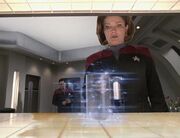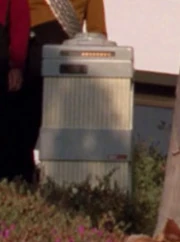
A replicator malfunctions and creates a mug - after the coffee.
A replicator (or food slot) is a device that uses transporter technology to dematerialize quantities of matter and then rematerialize that matter in another form.
24th century Federation starships are commonly equipped with replicators because they allow for a wider variety of foods and beverages to be served to crew members, since the selection is limited only by the software and the number of options that have been programmed. Many people find replicated foods and drinks to taste exactly the same as "real" food, although some people claim to be able to tell the difference. This is due to the replicator manufacturing food and beverages at the molecular level rather than at the quantum level as used by most transporter systems. (TNG: "Sins of the Father", "Relics"; DS9: "In the Pale Moonlight", "You Are Cordially Invited")
Spock used an early type of portable replicator to produce a marshmallow while camping out with James T. Kirk and Leonard McCoy. Star Trek V: The Final Frontier
Captain Jean-Luc Picard beamed down to Delta Rana IV with a portable matter replicator for the Uxbridges's. (TNG: "The Survivors")
Replicators can be used for replicating machine parts or clothing. They can even be used to replicate heavier machine parts, using a special type known as an industrial replicator. (DS9: "For the Cause")
Replicators may be capable of producing replacement organs for lifeforms in the ship's databanks. At the very least they are capable of producing artificial organs as replacement for lost/diseased organs. (VOY: "Phage")
Replicators are also one of the technologies used in holodecks and holosuites.

A portable matter replicator.
When the USS Voyager was pulled to the Delta Quadrant, it became clear that replicator technology was unknown to the indigenous people of that region. The Kazon in particular repeatedly tried to obtain this technology, as did other races. Captain Janeway feared that if this technology were acquired by a civilization before they were ready, disastrous consequences could ensue. For this reason, and because of the Prime Directive, Janeway refused to give up this technology at any price. (VOY: "State of Flux")
Replicators sample an object at a molecular rather than quantum level. The computer then applies a lossy compression algorithm to save computer memory. This gives the computer a pattern from which to produce copies.
Starships keep a small supply of recycled bulk material from which to create new objects. A waveguide conduit system sends bulk material to the replicator, which reforms it into the requested objects, then it transmits the new object to the terminal.
Quantum transformational manipulation allows the creation of new elements. Energy costs are high for all forms of replication, thus making practical alchemy, such as creating limitless latinum, impossible, but food (normally simple arrangements of water, proteins, and liquids) is more practical to replicate from bulk matter than to store.
